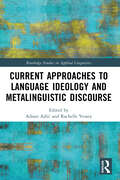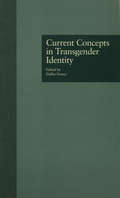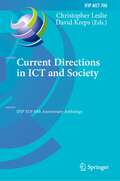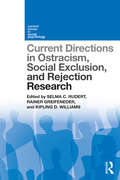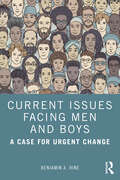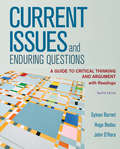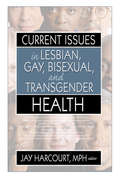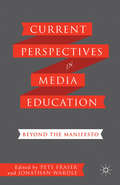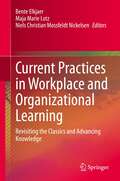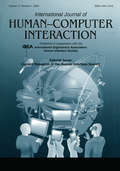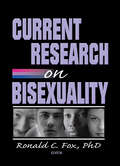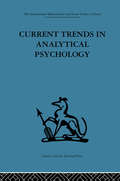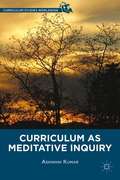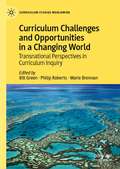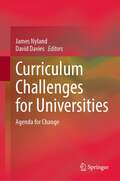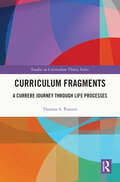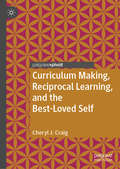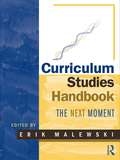- Table View
- List View
Current Approaches to Language Ideology and Metalinguistic Discourse (Routledge Studies in Applied Linguistics)
by Rachelle Vessey Adnan AjšićThis collection brings together research on cutting-edge developments at the intersection of language ideology and metalinguistic discourse, showcasing the potential of diverse approaches.With interest in language ideology and metalinguistic discourse growing, numerous qualitative and quantitative approaches have been established but have often resulted in a siloing of methods. Despite methodological advances, research on language ideology and metalinguistic discourse often relies on either qualitative methods (e.g., ethnography, content analysis) or traditional corpus linguistic techniques (e.g., concordance, collocation), with limited overlap between these “camps,” a division which has hindered a comprehensive understanding of the field. The book makes the case for bridging this gap by exploring the overlap between different approaches, demonstrating the nuanced insights a mixed methods perspective can provide. Featuring a wide range of applications across domains such as education, policy, minorities, traditional and social media, popular culture, and literature, the volume highlights the potential of integrating diverse methods. An afterword by Tommaso Milani ties these strands together, offering a forward-looking view of the field and potential directions for further research.This book will appeal to students and scholars in applied linguistics, language and education, and sociolinguistics.
Current Challenges and Emerging Teaching English as a Foreign Language Practice: Contributions from Latin America (English Language Teaching: Theory, Research and Pedagogy)
by Yomaira Angélica Herreño-ContrerasThis book brings together contributions on current challenges in Teaching English as a Foreign Language (TEFL) in Latin America. It examines various issues related to two areas within TEFL: first, in-class activities and innovative approaches, focusing on the development of intercultural competence, technology-based teaching and learning practices, grammar learning and digital life and its repercussions in English learning. Second, teacher education and professional development, analyzing aspects such as source-based writing skills, Lingua Franca and World Englishes, post-pandemic face-to-face instruction and literature in English as a Foreign Language (EFL) Teacher Education Programs along with studies on job satisfaction, attrition and professional identity. Specifically, the chapters provide an overview of the EFL teacher and classroom in Latin America, and the demands, benefits and drawbacks observed in this sociocultural context. Each chapter also includes meaningful views from a Latin American context and contributes to the development of better EFL teaching and learning practices worldwide. This book is a useful reference for scholars, researchers, and educators who focus on EFL teaching and learning at any educational level in Latin America. It is also a helpful resource for trainee teachers delving further into their fields.
Current Concepts in Transgender Identity (Garland Gay and Lesbian Studies #11)
by Dallas DennyFirst published in 1998. Routledge is an imprint of Taylor & Francis, an informa company.
Current Directions in ICT and Society: IFIP TC9 50th Anniversary Anthology (IFIP Advances in Information and Communication Technology #700)
by David Kreps Christopher LeslieThis project was motivated by the upcoming fiftieth anniversary of the IFIP Human Choice and Computers (HCC) conference, the event that led to IFIP’s Technical Committee 9 (TC 9). Although IFIP committees are mainly technical, TC 9 is dedicated to research at the intersection of information and communication technology (ICT) with society. In addition to sponsoring HCC, TC 9 supports groups that have specific research interests. In consultation with their members, the leaders of each group offer chapters about their groups’ history and goals. An additional chapter describes TC 9’s formation, and an appendix details the national groups that work closely with TC 9. Overall, this volume is a useful guide to the historical development of research on ICT and society, providing readers with important reference works and relevant themes, and also points to likely new trends in these domains.
Current Directions in Ostracism, Social Exclusion and Rejection Research
by Rainer Greifeneder Selma Rudert Kipling WilliamsThis edited volume provides an up-to-date review of current research on ostracism, social exclusion, and rejection. The book shows why exclusion and rejection occur, how they affect the excluded individuals, and the consequences they might have for individuals and organizations. Ostracism, social exclusion, and rejection are common phenomena, both at the individual level, such as ostracism in the classroom or at the workplace, as well as on a societal or even global scale, such as immigration or asylum policies. Examining key concepts such as the long-term effects of ostracism, the developmental and cultural perspective on ostracism, and the detrimental impact that social exclusion may have on individuals and societies, the authors provide an up-to-date overview of the research field and present new conceptual models and methodological approaches. Featuring discussion of promising areas, novel pathways for research, and cutting-edge developments, this is the most comprehensive bringing-together of research on this topic. The book gives both a broad state-of-the-art overview of the field as well as discussing cutting-edge ideas and promising areas for future research; it is essential for students, researchers of social psychology, and policy makers interested in this field.
Current Flow: The Electrification of Palestine
by Ronen ShamirWhether buried underfoot or strung overhead, electrical lines are omnipresent. Not only are most societies dependent on electrical infrastructure, but this infrastructure actively shapes electrified society. From the wires, poles, and generators themselves to the entrepreneurs, engineers, politicians, and advisors who determine the process of electrification, our electrical grids can create power#151;and politics#151;just as they transmit it. Current Flow examines the history of electrification of British-ruled Palestine in the 1920s, as it marked, affirmed, and produced social, political, and economic difference between Arabs and Jews. Considering the interplay of British colonial interests, the Jewish-Zionist leanings of a commissioned electric company, and Arab opposition within the case of the Jaffa Power House, Ronen Shamir reveals how electrification was central in assembling a material infrastructure of ethno-national separation in Palestine long before "political partition plans" had ever been envisioned. Ultimately, Current Flow sheds new light on the history of Jewish-Arab relations and offers broader sociological insights into what happens when people are transformed from users into elements of networks.
Current Issues Facing Men and Boys: A Case for Urgent Change
by Benjamin A. HineThis important book offers an accessible overview and timely examination of the unique challenges faced by men and boys in contemporary society.It covers a wide range of topics, including the male mental health crisis, the impact of media and popular culture on male identity, and issues related to body image, as well as education, work, sexual behaviour, relationships, and the evolving roles of fatherhood. Additionally, it addresses the prevalence of violence, homelessness, substance misuse, and specific issues faced by men in institutional settings like the military and prison. Written in a user-friendly style, each chapter contains summary action points and signposts to further resources where relevant. The book takes an intersectional approach throughout, which continually considers the role of gender, ethnicity, religion, culture, class, and sexuality in the lives of men and boys. It therefore serves as an inclusive and comprehensive resource for promoting a more compassionate society, highlighting the need for evidence-based interventions and strategies to foster meaningful change that supports the well-being of men and boys.Emphasizing that addressing men's issues complements and reinforces the broader fight for gender equality, this practical book is highly relevant for mental health professionals, educators, and other practitioners who are interested in understanding the unique challenges that men and boys face. It will also be useful reading for students of psychology, gender studies, sociology, health and social care, and many other subjects.
Current Issues and Enduring Questions: A Guide To Critical Thinking And Argument, With Readings
by Barnet Badau O’HaraCurrent Issues and Enduring Questions is a text and reader that serves as an extensive resource for teaching argument, persuasive writing, critical thinking, and research. It includes readings on topics that matter to students, such as being seen as “the other” and student loan forgiveness, issues that students will want to engage with and debate. Comprehensive coverage of classic and contemporary approaches to argument includes Aristotelian, Toulmin, Rogerian, and a range of alternative views, such as analyzing and writing about visual arguments. <p><p> This new edition does more than ever to make argument concepts clear, and to give students strategies for crafting effective arguments. For today’s ever-increasingly visual learners who are challenged to separate what’s real from what’s not, new activities and visual flowcharts support information literacy. Newly annotated readings highlight important rhetorical moves. And new readings explore controversial issues such as mass incarceration, cultural appropriation, and the way computer algorithms make biased decisions.
Current Issues in Lesbian, Gay, Bisexual, and Transgender Health
by Mph Jay HarcourtLearn what resources are needed for lesser-recognized LGBT health issuesMost literature that explores LGBT health issues concentrates on HIV/AIDS while leaving research studies on other vital issues lacking. Current Issues in Lesbian, Gay, Bisexual, and Transgender Health addresses this inadequacy by presenting a broad range of LGBT health issues from an interdisciplinary and mixed-method perspective. Leading experts present both quantitative and qualitative descriptions of health issues among various population groups, focusing on those topics poorly represented in present-day literature. This book is a strong start to fill in the blanks about unrealized health issues of LGBT individuals and offers insights into the resources needed to address them.Methods to assess sexual orientation and gender identity are not normally found in most population-based research. Because of the diversity within the relatively small LGBT population, research has been forced to generalize, making it less likely to effectively contribute to quality health issue data for these individuals. The research presented in Current Issues in Lesbian, Gay, Bisexual, and Transgender Health takes particular care to specify how the orientation and sexual identity of study participants was measured. This book carefully mines previously unrevealed health disparities among LGBT populations across a broad spectrum of diseases-beyond the standard focus on HIV/AIDS. The most current and important studies are presented, including rare research on transgender health issues. The chapters are extensively referenced, and several include figures and tables to clarify and enhance understanding of the information.The wide range of topics in Current Issues in Lesbian, Gay, Bisexual, and Transgender Health include: the inclusion of sexual orientation questions in research studies comparison of mental health issues between women of different sexual orientations mental health issues among men of different sexual orientations and HIV status in Australia the impact of sexual identity distress and social support in GLBT youth issues transgender youth health issues female-to-male (FTM) transexuals&’ experiences accessing health care research on LBT domestic violence survivors health needs of male-to-female (MTF) transgenders of colorCurrent Issues in Lesbian, Gay, Bisexual, and Transgender Health is crucial, thought-provoking reading for researchers working in LGBT health, public health professionals working in community health and LGBT health, policymakers, advocates, public health and community health faculty, and students interested in LGBT health issues.
Current Perspectives in Media Education: Beyond the Manifesto (Education, Economy And Society Ser.)
by J. Wardle P. FraserThis book emerged from the online project 'A Manifesto for Media Education' and takes forward its starting points by asking some of the original contributors to expand upon their view of the purpose of media education and to support their perspective with accounts of practice.
Current Perspectives on Centenarians: Introduction to Lifespan and Healthspan (International Perspectives on Aging #36)
by Maria D. Llorente Raya Elfadel KheirbekThis book explores various aspects related to human longevity and aging beyond 100 years old. It examines all domains of health and well-being of this elite group including the current demographics, genetics and epigenetics of exceptional longevity, cardiovascular risk factors, dementia, nutrition, physical activity, African American and Hispanic centenarians, financial planning, religion, spirituality, whole health, wellness, oral health, and nature. The book also delves into the lives of supercentenarians, defined as expert survivors who have lived beyond 110 years old. The implications of the Age-Friendly Healthcare Systems (AFHS) Movement on the care of centenarians are also discussed. This book is a valuable resource for healthcare professionals, epidemiologists, public health professionals, policy makers, and anyone interested in the study of aging and longevity.
Current Practices in Workplace and Organizational Learning: Revisiting the Classics and Advancing Knowledge
by Bente Elkjaer Maja Marie Lotz Niels Christian Mossfeldt NickelsenThe central assumption that guides this book is that research and practice about learning at the workplace has recently lost its critical edge. This book explores what has happened to workplace learning and organizational learning and studies what has replaced it. In addition, the book discusses to what extend there are reasons to revitalize it. Today, themes such as ‘innovation’, ‘co-creation’ and ‘knowledge sharing’ seem to have become preferred and referred to as theoretical fields as well as fields of practice. In several chapters of this book it is argued that the critical power of learning could be regained by starting a new discussion of how these new fields of practice can be substantiated by topics such as learning arrangements, learning mechanisms, and learning strategies. Hence, the aim of this book is to both advance and recapture our knowledge of learning in today’s increasingly complex world of work and organizing. The contributions in this work do so by revisiting classic research on workplace and organizational learning and discussing how insights from this body of literature evokes new meaning. It sets the stage for new agendas and rethinks current practices that are entangled in activities such as innovation, co-creation, knowledge sharing or other currently widespread fields of practice.
Current Research in Bilingualism and Bilingual Education (Multilingual Education #26)
by Piotr Romanowski Małgorzata JedynakThis book covers research topics in bilingual education, language policies, language contact, identity of bilingual speakers, early bilingualism, heritage languages, and more, and provides an overview of current theory, research and practice in the field of bilingualism. Each chapter is written by a specialist in the field. Part I focuses on the numerous and heterogeneous relations between languages as well as the implications arising from bilingual speech processing. In Part II, a series of contextualized studies on bilingual classrooms are presented, with diverse research designs applied in different educational settings being a key feature of these studies. Part III bridges theory and practice by offering an insight into mono- and multilingual school settings showcasing examples of educational institutions where bilingualism successfully soared and depicts the needs related to language education.
Current Research of the Human Interface Society: A Special Issue of the international Journal of Human-computer Interaction
by Osamu KataiThis special issue is the first opportunity to introduce the research activities of the Human Interface Society. The first article gives a microworld approach to identify design requirements for better situation awareness. Next, a focus on evaluation of organizational structure in emergency situations from the communication viewpoints is examined,
Current Research on Bisexuality
by Ronald FoxCurrent Research on Bisexuality is an important resource on recent psychological and sociological findings in bisexual studies. The authors provide research findings and case studies that add to our understanding of bisexual identity, bisexuality and relationships, bisexuality and ethnicity, and attitudes toward bisexual people. This book examines research findings, literature reviews, and a wealth of resources that currently exist on bisexuality and bisexual issues. This book will bring you up to date on: bisexual identity development bisexuality in college students cross-orientation friendships of bisexual women bisexual married women and men-and their spouses bisexuality and heterosexually married couples monogamous as well as open bisexual relationships the interrelationship of bisexuality, race, and ethnicity attitudes toward bisexual women and bisexual men Current Research on Bisexuality also contains a comprehensive reader&’s guide to the current social science literature about bisexuality. This bibliography brings together a wide range of nonfiction books, journal articles, book chapters, theses, and dissertations on bisexuality with a focus in the theoretical, research clinical, and community perspectives that have that have developed in the last twenty years. This reading list is essential for students, educators, researchers, and practitioners in psychology, counseling, social work, psychiatry, education, sociology, and anthropology. Current Research on Bisexuality provides new knowledge of the life experiences of bisexual people. With this book, you&’ll find a basis for further research and education about bisexuality in the greater context of ongoing research, education, and advocacy regarding lesbian, gay, bisexual, and transgender issues.
Current Topics in the Theory and Application of Latent Variable Models
by Michael C. Edwards Robert C. MacCallumThis book presents recent developments in the theory and application of latent variable models (LVMs) by some of the most prominent researchers in the field. Topics covered involve a range of LVM frameworks including item response theory, structural equation modeling, factor analysis, and latent curve modeling, as well as various non-standard data structures and innovative applications. The book is divided into two sections, although several chapters cross these content boundaries. Part one focuses on complexities which involve the adaptation of latent variables models in research problems where real-world conditions do not match conventional assumptions. Chapters in this section cover issues such as analysis of dyadic data and complex survey data, as well as analysis of categorical variables. Part two of the book focuses on drawing real-world meaning from results obtained in LVMs. In this section there are chapters examining issues involving assessment of model fit, the nature of uncertainty in parameter estimates, inferences, and the nature of latent variables and individual differences. This book appeals to researchers and graduate students interested in the theory and application of latent variable models. As such, it serves as a supplementary reading in graduate level courses on latent variable models. Prerequisites include basic knowledge of latent variable models.
Current Trends in Analytical Psychology: Proceedings of the first international congress for analytical psychology
by Gerhard AdlerTavistock Press was established as a co-operative venture between the Tavistock Institute and Routledge & Kegan Paul (RKP) in the 1950s to produce a series of major contributions across the social sciences. This volume is part of a 2001 reissue of a selection of those important works which have since gone out of print, or are difficult to locate. Published by Routledge, 112 volumes in total are being brought together under the name The International Behavioural and Social Sciences Library: Classics from the Tavistock Press. Reproduced here in facsimile, this volume was originally published in 1961 and is available individually. The collection is also available in a number of themed mini-sets of between 5 and 13 volumes, or as a complete collection.
Curriculum As Meditative Inquiry
by Ashwani KumarKumar asks in this volume: Since characteristic features of human consciousness - fear, conditioning, and fragmentation - work against the educational experience, how can we re-imagine curriculum as a space for meditative inquiry and allow it to provide transformative educational experiences to teachers and their students?
Curriculum Challenges and Opportunities in a Changing World: Transnational Perspectives in Curriculum Inquiry (Curriculum Studies Worldwide)
by Marie Brennan Bill Green Philip RobertsThis book brings together voices and perspectives from across the world and draws in a new generation of curriculum scholars to provide fresh insight into the contemporary field. By opening up Curriculum Studies with contributions from twelve countries—including every continent—the book outlines and exemplifies the challenges and opportunities for transnational curriculum inquiry. While curriculum remains largely shaped and enabled nationally, global policy borrowing and scholarly exchange continue to influence local practice. Contributors explore major shared debates and future implications through four key sections: Decolonising the Curriculum; Knowledge Questions and Curriculum Dilemmas; Nation, History, Curriculum; and Curriculum Challenges for the Future.
Curriculum Challenges for Universities: Agenda for Change
by David Davies James NylandThis book develops a progressive program of engagement with issues, problems and critical thinking which helps universities and students understand and engage with some of the key issues of our time. It focuses on curriculum concerns, and presents a sustained and critical analysis and dialogue about knowledge, culture and ways of seeing important issues. This book provides critical and analytical insights into the importance of the emergence of mass higher education into public awareness. It explores what is termed ‘contested knowledge’ as part of modern students’ experiences and expectations. By broadcasting some of the future prospects for a democratic university, especially in relation to its communities, it highlights the need to grasp the significance of global change and instability in teaching and learning, and how an adequate curriculum in higher education can be constructed to address the issues that arise.
Curriculum Epistemicide: Towards An Itinerant Curriculum Theory (Routledge Studies in Education, Neoliberalism, and Marxism)
by João M. ParaskevaAround the world, curriculum – hard sciences, social sciences and the humanities – has been dominated and legitimated by prevailing Western Eurocentric Anglophone discourses and practices. Drawing from and within a complex range of epistemological perspectives from the Middle East, Africa, Southern Europe, and Latin America, this volume presents a critical analysis of what the author, influenced by the work of Sousa Santos, coins curriculum epistemicides, a form of Western imperialism used to suppress and eliminate the creation of rival, alternative knowledges in developing countries. This exertion of power denies an education that allows for diverse epistemologies, disciplines, theories, concepts, and experiences. The author outlines the struggle for social justice within the field of curriculum, as well as a basis for introducing an Itinerant Curriculum Theory, highlighting the potential of this new approach for future pedagogical and political praxis.
Curriculum Fragments: A Currere Journey through Life Processes (ISSN)
by Thomas S. PoetterThis book builds upon Louise Berman’s late 20th-century framing of life processes to inform school curriculum, by proposing a new curriculum project that extends and reframes Berman in and beyond schooling.Using the well-established curriculum theorizing method, currere, the author focuses on seven life processes, including knowing, loving, losing, growing, forgiving, relating, and hoping. Each of these is approached using currere-oriented, autobiographical fragments – stories from the author’s own lived experiences in education and life – that illuminate the educational, curricular, and pedagogical possibilities of each of the seven processes using past, present, and future perspectives, which the author calls curriculum fragments. These curriculum fragments are tied to historical and contemporary curriculum theorizing and educational theory and practice, in order to suggest considerations for movement for the reader, scholar, educator, and leader. It ultimately asks whether humanity can create a joyful, beautiful, and just curriculum of life for each and every person through schooling and beyond, and consequently, a better world built on love.Focusing on real-life experiences in school and life that have educational implications and that can inform the curriculum, the field of curriculum studies, and the act of curriculum theorizing, this book will appeal to curriculum scholars interested in using currere, understanding patterns of use, participating in the production of curriculum and educational knowledge in the field, and perceiving and using curriculum theorizing as an integral part of their daily work.
Curriculum Making, Reciprocal Learning, and the Best-Loved Self (Intercultural Reciprocal Learning in Chinese and Western Education)
by Cheryl J. CraigThis book revolves around curriculum making, reciprocal learning, and the best-loved self. It draws on extensive school-based studies conducted with teachers in the United States, China, and Canada, and weaves in experiences from other cross-national projects, keynote addresses, archival research, and editorial work. The elucidation of the ‘best-loved self’ drives home the point that teachers are more than the subject matter they teach: they are students’ role models and allies. Curriculum making and reciprocal learning relationships enrich teachers’ and students’ being and becoming as they live curriculum alongside one another—with the goal of more satisfying lives held firmly in view.
Curriculum Renewal for Islamic Education: Critical Perspectives on Teaching Islam in Primary and Secondary Schools (Routledge Research in Religion and Education)
by Nadeem A. MemonThis book demonstrates why and how it is necessary to redesign Islamic Education curriculum in the K-12 sector globally. From Western public schools that integrate Muslim perspectives to be culturally responsive, to public and private schools in Muslim minority and majority contexts that teach Islamic studies as a core subject or teach from an Islamic perspective, the volume highlights the unique global and sociocultural contexts that support the disparate trajectories of Islamic Education curricula. Divided into three distinct parts, the text discusses current Islamic education curricula and considers new areas for inclusion as part of a general renewal effort that includes developing curricula from an Islamic worldview, and the current aspirations of Islamic education globally. By providing insights on key concepts related to teaching Islam, case studies of curriculum achievements and pitfalls, and suggested processes and pillars for curriculum development, contributors present possibilities for researchers and educators to think about teaching Islam differently. This text will benefit researchers, doctoral students, and academics in the fields of secondary education, Islamic education, and curriculum studies. Those interested in religious education as well as the sociology and theory of religion more broadly will also enjoy this volume.
Curriculum Studies Handbook - The Next Moment (Studies in Curriculum Theory Series)
by Erik MalewskiWhat comes after the reconceptualization of curriculum studies? What is the contribution of the next wave of curriculum scholars? Comprehensive and on the cutting edge, this Handbook speaks to these questions and extends the conversation on present and future directions in curriculum studies through the work of twenty-four newer scholars who explore, each in their own unique ways, the present moment in curriculum studies. To contextualize the work of this up-and-coming generation, each chapter is paired with a shorter response by a well-known scholar in the field, provoking an intra-/inter-generational exchange that illuminates both historical trajectories and upcoming moments. From theorizing at the crossroads of feminist thought and post-colonialism to new perspectives that include critical race, currere, queer southern studies, Black feminist cultural analysis, post-structural policy studies, spiritual ecology, and East-West international philosophies, present and future directions in the U.S. American field are revealed.
